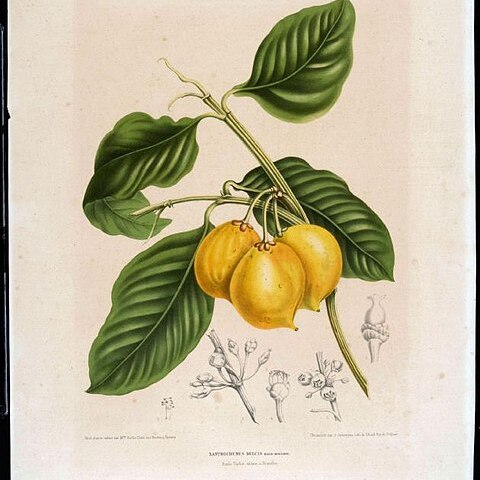Tree to 20 m high, dioecious; exudate white in stems and petioles, yellow in fruit. Twigs fluted, ribbed, light green, pendulous. Leaves glabrous; petiole 11–30 mm long, 3–3.5 mm wide, channelled, ligulate; lamina discolorous, chartaceous to coriaceous, elliptic to ovate or oblong-ovate, (7.5–) 9.5–22 (–28) cm long, (3.2–) 5–9 (–18) cm wide, base attenuate, cuneate, obtuse, cordate or asymmetrical, margin recurved, apex shortly acuminate, acute or obtuse; venation brochidodromous, primary vein ±flush on upper surface and protruding on abaxial surface; secondary veins 9–14 pairs, divergence from primary vein 30–60o, prominently or slightly raised above and below; submarginal veins on lamina underside 1–2 mm from the margin. Inflorescences axillary. Flowers 5–15 mm diam.; sepals 5, orbicular; petals 5, oblong, 8 mm long; stamens in 5 narrow phalanges with a sterile cluster or fasciclode between each fertile cluster, not adnate to petals, pistillode present; ovary 5-locular. Fruit a fleshy berry, ovoid, globular or depressed globular, (25–) 35–50 mm long, (26–) 45–53 mm wide, yellow, apex often beaked; fruiting calyx lobes 5, 3–5 mm long.
More
A bushy tree up to 10-20 m high. It spreads 2-4 m wide. It has a short trunk. It has 4 angled yellow drooping branches. It has large leathery leaves 10-30 cm long and 4-14 cm wide. The leaves are opposite, smooth and somewhat oval in shape. Young leaves are pale green and older leaves are dark green. The leaves are shiny above and often hairy underneath. The leaf stalk is 2 cm long. Male and female flowers are separate. The flowers are white or greenish yellow and borne in small rounded clusters. Male flowers are very small. The flowers have a sour smell. The fruit is smooth, yellow and the size of a small orange but with a point at the end. It is 5-8 cm wide. It has a thin skin and 1 to 5 seeds inside. These are brown and 2.5 cm long. The pulp is yellow.
A tropical plant. It suits the hot, wet tropical lowlands. They are common and widely distributed in the Philippines from northern Luzon to the southern part growing in primary forest at low and medium altitudes. It grows in coastal areas up to 500 m altitude. It is not particular as regards soil.
More
Grows in deep alluvial soil derived from a mixture of metamorphic rocks and granite, in lowland mesophyll vineforest, riverine vineforest, and semi evergreen vine forest.


